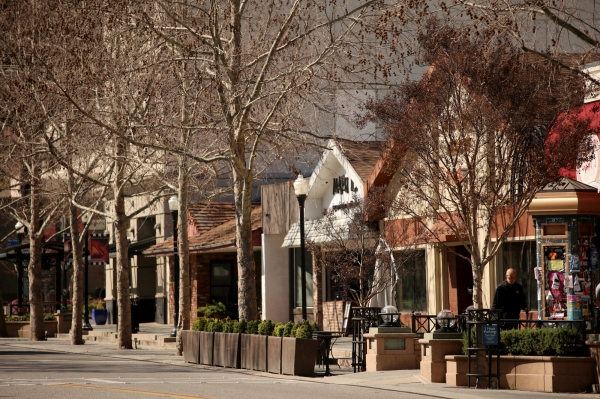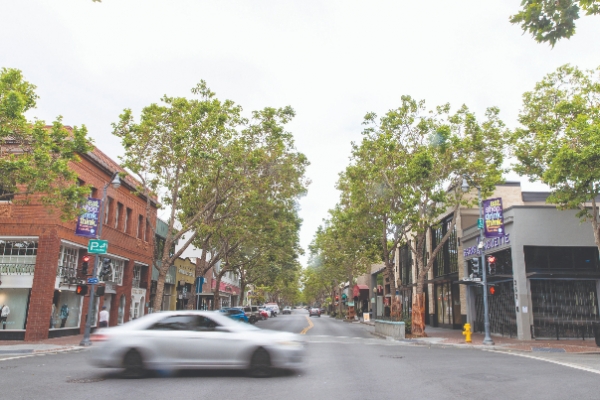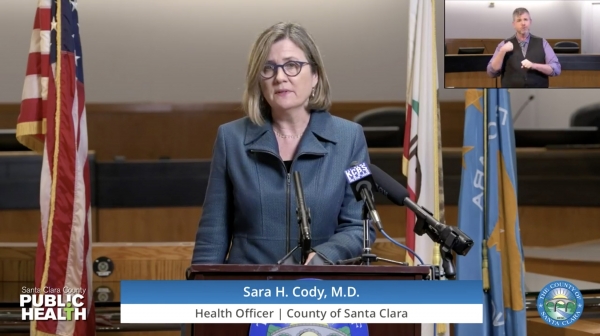Book shops, clothing stores and other businesses in Santa Clara County that allow storefront pickup can start reopening Friday, provided they can limit their employee count and demonstrate their compliance with social-distancing rules, county leaders announced Monday.
With the amended order, Santa Clara County joined the wave of Bay Area counties beginning the transition into the second phase of reopening of the economy, consistent with recent guidance from Gov. Gavin Newsom.
San Mateo County announced last Friday that it is allowing retailers such as book stores, florists, clothing stores and toy stores to operate with curbside pickup, effective today (May 18). Retailers in San Francisco, Marin, Alameda and Contra Costa counties also resumed operations today, subject to curbside mandates and social-distancing restrictions.
In Santa Clara County, any retailers that can provide curbside service will have to limit their employee count to one employee per 300 square feet of space, under the new order. In addition, they will have to fill out a new five-page protocol sheet, detailing what they have done to prevent coronavirus transmission. They will also have to post a sheet for visitors that lists their safety measures and a county-issued "COVID-19 Prepared" certificate.
"We want people to know what the business has done to be compliant with these protocols so that folks feel safe and are safe in entering those facilities and conducting business, and employees feel safe around working there," County Counsel James Williams said during a Monday press conference announcing the changes.
The order also allows car parades, as well as the reopening of outdoor museums, outdoor historical sites and publicly accessible gardens, Williams said.
The Monday order represents the county's first easing of shelter-in-place restrictions since May 4, when construction work was permitted to resume and gardeners were allowed to go back to work. In the two weeks since then, the county has not seen a dramatic increase in cases, suggesting that it is safe to further relax the shelter-in-place restrictions that had been in effect since March 17.
Dr. Sara Cody, the county's health officer, said the decision was driven by data. The number of new cases in the county is stable and has been decreasing, she said, "significantly reducing the doubling time for new cases." She noted that Santa Clara County started with more cases than any county in the state but today accounts for just 3% of California cases.
Cody said the number of patients requiring hospitalization for COVID-19 has been consistently trending down and that the hospitals have the beds and the staffing they need to "take care of any patient in any need."
And while the county remains far from its goal of 4,000 tests per day, Cody noted that its testing shortfall has significantly decreased. While in early April, the county was usually doing fewer than 600 tests per day, on one recent day the number of tests was up around 1,600. The positivity rate of tests has dropped from 9% in early April to 1% to 1.5% these days, which Cody said is a "very significant improvement."
"With this progress, we can now take another step forward in gradually reopening," Cody said.
Even though Santa Clara is one of the last counties in the Bay Area to begin reopening businesses, county leaders pushed back against the notion that they were pressured to relax the shelter-in-place because other parts of the state are moving faster. When asked about that, Williams and Cody pointed to the fact that the county's last modification to the health order came two weeks ago. Because the incubation period for COVID-19 is about 14 days, the county waited this long to see the effects of the May 4 order.
The fact that cases have continued to decline and that hospital capacity remains robust prompted the decision to further relax restrictions, Cody said. An increase in testing and contact tracing capacity also contributed to the decision.
"The big picture is, of course we want to move as quickly as we can as there are significant health harms with the social and economic disruption, but we have to be able to look at our data to understand whether we have the headroom to take that next step," Cody said. "I think here in Santa Clara County we have the headroom. Not a lot, but we probably have more headroom here than many, many, many other places."
Find comprehensive coverage on the Midpeninsula's response to the new coronavirus by Palo Alto Online, the Mountain View Voice and the Almanac here.





Comments
Sylvan Park
on May 18, 2020 at 5:26 pm
on May 18, 2020 at 5:26 pm
There is no vaccine or cure. May never be either. President Trump's talk of things getting before right after the election is just a CON-JOB. The mortality rate so far in the USA is 6% of those infected. Might more testing find more cases and reduce the mortality rate calculation? Yes. Meanwhile, 6% of 330 million Americans is 19.8 million DEAD - many dying in expensive ICUs in excruciating pain and alone. And how many survivors are left disabled or vulnerable to other issues? A bit early to celebrate, I'd suggest.
Old Mountain View
on May 18, 2020 at 5:35 pm
on May 18, 2020 at 5:35 pm
Gary, those numbers you cite are way off. What we want to look at is the IFR (infection fatality rate). How many of infected people die? It turns out the number is between 0.2% on the low end to about 0.7% on the high end, sucks, but not the apocalypse. Furthermore, people under 40 without other health issues basically die at a rate of zero, it's the rest of us who are in increasing danger due to age and age related problems. Read about the 1969 flu pandemic, for example, it was as bad as covid 19 and the world moved on. Here is some hard data from Italy, for example, who's had a worse time of it than others due to a generally older society. Their IFR (PFR they call it) is 0.58%, 1/10 of what you claim. Web Link
I'm glad to hear our economy is starting to open up, if even a little bit. Some of us have the luxury of working from home in our nice white collar jobs, but some people have no such choice and are really hurting right now. The stress of joblessness and impending destitution kill too, and it's what we've forced on a large part of society.
Sylvan Park
on May 18, 2020 at 6:29 pm
on May 18, 2020 at 6:29 pm
The number of confirmed cases in America is 1.5 million. 90,000 deaths. Simple math. You cite no evidence that the number of infected Americans is higher
Old Mountain View
on May 18, 2020 at 7:57 pm
on May 18, 2020 at 7:57 pm
Right, nobody knows the actual number, it's a guess. We have 1.5 million confirmed infected, but far many more unconfirmed infected or asymptomatic, you can't just take a fraction of a partial denominator.
Stanford updated their prevalence study recently; Web Link
What is says that in santa clara county, with 95% confidence, 50x as many people are infected as are confirmed sick with covid-19. You can't extrapolate that to the US, but if you did, you would have 90,000 / 75 million = 0.12% IFR. The number is different in different parts of the country, and best guess I've seen it's about 20x nationally, so 90,000 / 30 million = IFR of 0.3%.
There's no need to make this thing scarier than it is, it's bad enough, and using scary numbers doesn't help. We have antibody studies happening all over the country to figure out how many people are actually infected, not how many are showing up at the hospital, which is the sickest of the sick.
Old Mountain View
on May 18, 2020 at 10:05 pm
on May 18, 2020 at 10:05 pm
Marcin, not that I expect a dogmatic libertarian to respond to reason, but that Stanford study has been pretty thoroughly debunked. See this discussion for earlier analysis: Web Link
Considering they rushed to the press to oppose any restrictions with basic statistical errors in their study (let alone one of the primary researcher's wives recruiting study participants from her elementary school with misleading information), a rational observer should take their study with a grain of salt at best. Note that even with all of this, they haven't released any of their data. Bad science, further demonstrated by the recent revelations that they were funded by and in correspondence with anti-restriction activists.
Sylvan Park
on May 18, 2020 at 10:54 pm
on May 18, 2020 at 10:54 pm
Let's assume that the Stanford study you cite is valid and reveals that most people exposed to the virus so as to produce antibodies do not come down with the disease. That is good news BUT it appears most disease victims were subjected to exposure to a higher virus load. That would explain why the disease appears throughout families and in other group settings. People exposed a little and testing positive for some antibodies could still be subject to the disease when exposed to more of the virus. Among confirmed cases of the disease, 6% have died.
Gemello
on May 18, 2020 at 11:01 pm
on May 18, 2020 at 11:01 pm
The death rate is up since COVID-19 AND the rate is higher than the number of COVID-19 cases alone. Meaning that COVID-19 is NOT simply an upper respiratory disease.
Many more people have died due to complications of COVID-19 that have NOT been tested.
We simply do NOT know everything about COVID-19.
I will bet a nice home in Silicon Valley that they will find COVID-19 related deaths prior to the current earliest known death in February. The virus was in Wuhan in October 2019 (and probably earlier). How many flights from October to February do think there was in the SF Bay Area from Wuhan/China???
Old Mountain View
on May 19, 2020 at 1:09 pm
on May 19, 2020 at 1:09 pm
@libertarians:
What does believing in smaller government have to do with the studies? The Stanford paper I posted is to their revised paper, post-ridicule, and having gone through some amount of peer review. It's not been refuted, but they've tightened up their numbers and they're closer in line with the other cities. Boston just reported results from a similar study: Web Link Boston is seeing 0.67% IFR, a far cry from 5%.
It's not productive to dismiss some study as being an example of ideology or something - they have to stand on their own under peer review, and there are a dozen studies confirming numbers in line with Stanford's in multiple cities, like the one I just posted from Boston.
You can't pick and choose results when it comes to these kinds of things. You can, for example, point to a study in a different city which shows that numbers in Santa Clara are out of whack, or show that they are anomalous compared to other studies, but that simply is not the case. We have one outlier, NYC, and all the other studies are consistent with each other.